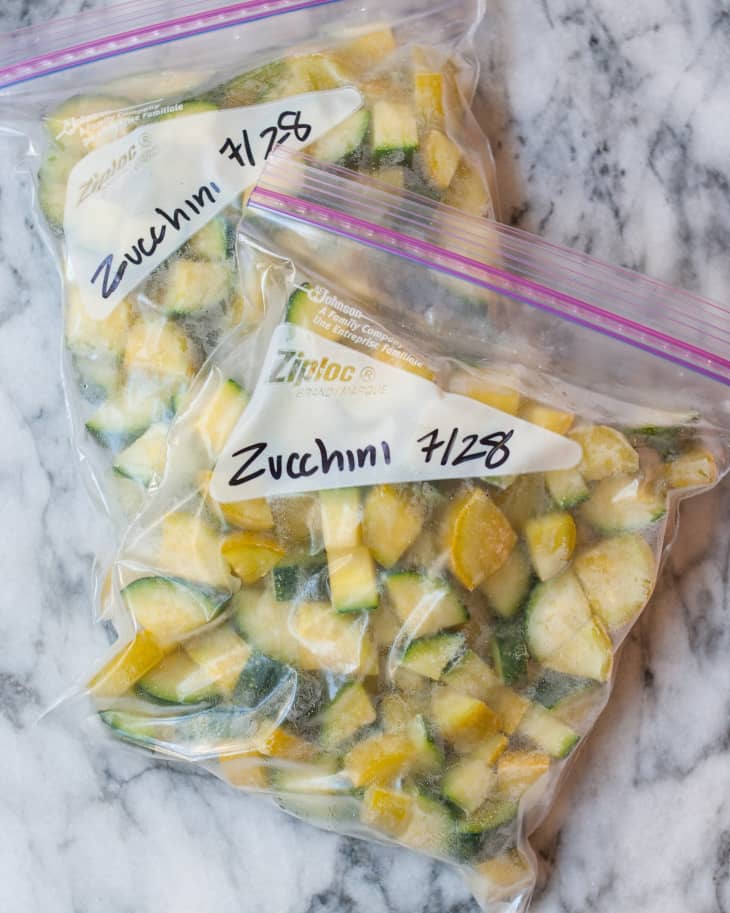How To Freeze Zucchini

What do you do when life hands you zucchini? Well, first you make zucchini bread. Then you make zucchini muffins. Then you make some zoodles, plus these roll-ups, followed by more zoodles. And then, because you’ve still barely made a dent in the zucchini pile, you freeze it for winter. Here’s how.
Blanch Before Freezing
Yes, you could chop up your zucchini and freeze it just as it is, but I think it’s worth your effort to blanch it first. Blanching — giving the zucchini a quick dunk in boiling water — deactivates the enzymes that would otherwise cause the zucchini to become mushy and discolored. The texture after freezing still isn’t quite the same as when the zucchini was fresh, but blanching means the pieces will stay reasonably firm even after thawing.
Don’t blanch for too long, though — a minute in boiling water will do the trick. More than that cooks the zucchini too much and can make it mushy after thawing, despite your best efforts.
But Don’t Add Salt!
Most of the time, I would recommend adding some salt to the water before blanching to give the vegetables some extra flavor on their way to the table. But in this case, the salt absorbed into the vegetable would soften the cell walls and — you guessed it! — make the zucchini mushy. So hold the salt for now; instead add it when you make your finished dish.
Freeze It Twice!
If you freeze the zucchini right after blanching, it will freeze up into a solid zucchini ice cube. Not the end of the world, but also less user-friendly when you just want to get dinner on the table.
If you have time and freezer space, a better solution is to freeze the zucchini in a single layer on a baking sheet lined with a silicon baking mat. This freezes each cube of zucchini individually, so they can be stored as a loose bundle in a freezer bag or container — much easier to scoop out exactly what you need for your recipe, plus the smaller pieces thaw more quickly during cooking.
Cooking with Frozen Zucchini
Frozen zucchini is best used in dishes alongside other vegetables, like soups, casseroles, and pasta sauces. You can add the frozen zucchini directly to the pot — no need to thaw! Frozen zucchini is less suited for things like stir-fries, steamed vegetable side dishes, or salads.
How To Freeze Zucchini
Nutritional Info
Ingredients
- Zucchini and summer squash, any amount
Equipment
- Large pot
- Large bowl
- Strainer
- Slotted spoon
- Baking sheet
- Silicon baking mat
- Clean dishtowel
- Freezer bags or containers
Instructions
Cut the zucchini into bite-sized pieces. Think about how you'll most likely be using the zucchini later on when you chop them up. For soups and casseroles, small bite-sized pieces are great.
Bring a large pot of water to a rolling boil. Fill a large bowl with ice water, settle a strainer inside, and place this near the stove.
Blanch the zucchini for 45 to 60 seconds. When done, the zucchini should still be crisp-tender and taste raw in the middle.
Shock the zucchini in the ice water: Scoop the zucchini from the water and transfer to the ice water bath to cool.
Arrange the zucchini in a single layer on a baking sheet lined with a silicon baking mat. Pat the tops of the zucchini dry with a clean dishtowel; you won't get the zucchini completely dry, but even patting them a little bit helps prevent puddles and big ice crystals from forming.
Freeze until solid. Put the whole baking sheet of zucchini in the freezer to freeze overnight.
Transfer the frozen zucchini to freezer bags or containers. Lift the corners of the baking mat to dislodge the zucchini, then gather them into bags or containers.
Label and date the containers, and freeze for up to 3 months. The zucchini will technically keep longer than 3 months, but freezer burn will gradually affect the flavor and texture of the zucchini.
Recipe Notes
This post has been updated — first published July 2008.
